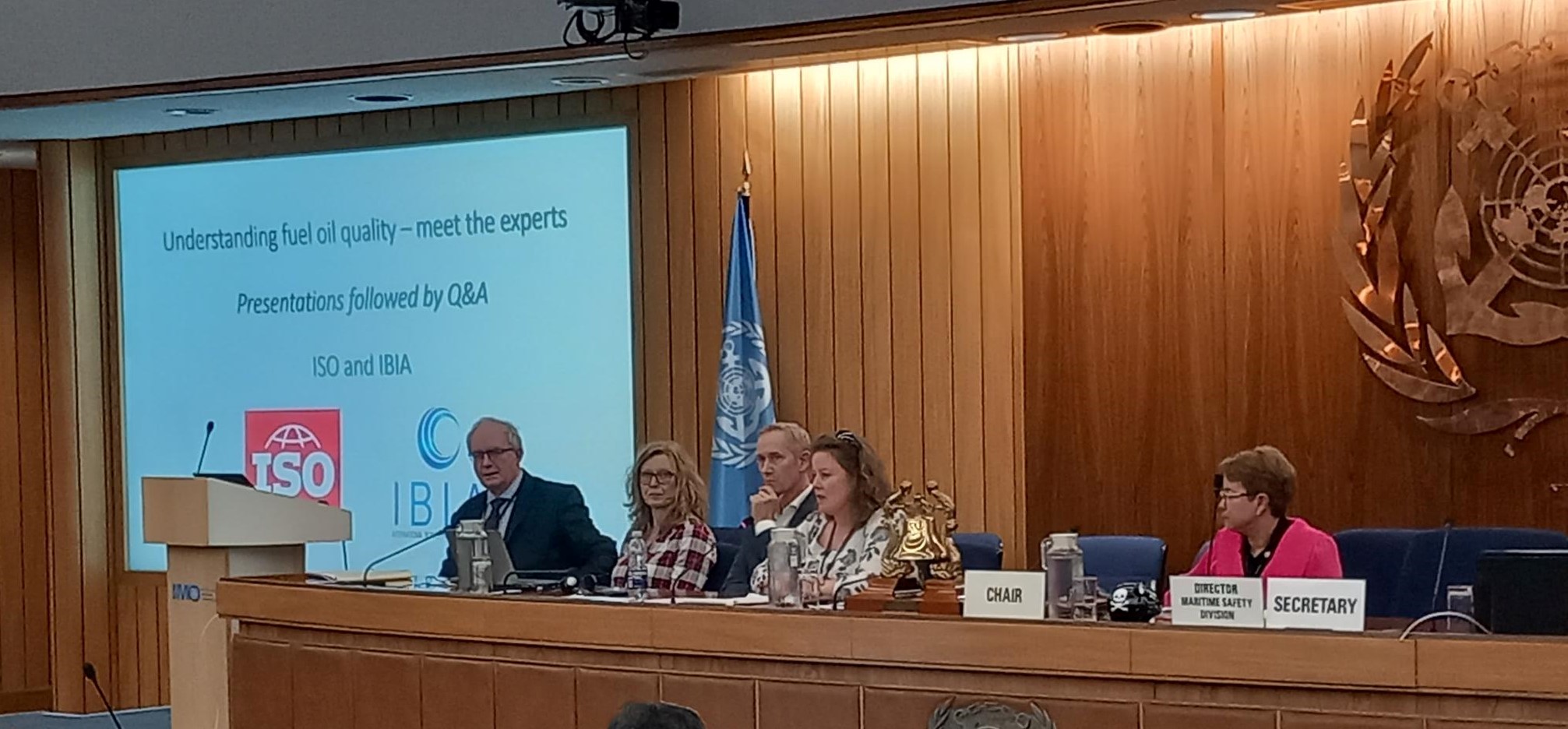IBIA and ISO provide key input on fuel quality to IMO meeting

IBIA and ISO made a a real impact at the IMO’s recent Maritime Safety Committee meeting, MSC 107 (31 May to 9 June), where we provided presentations followed by a Q&A session to elaborate on the subjects covered in our joint paper, MSC 107/6/4. It was a great opportunity to bring more clarity to long-running discussions on fuel oil safety at the IMO, and it was very well received by IMO delegates who found our session very informative.
In MSC 107/6/4, IBIA and ISO described why we would not recommend making the ISO 8217 standard mandatory (one of the proposals under discussion at MSC 107). Our paper also outlined test precision principles as per ISO 4259, and explained why it is considered unadvisable to regulate oil fuel parameters other than flashpoint due to uncertainties in establishing clear and consistent links between specific fuel parameters and the safety of ships.
Early on during MSC 107, on June 1, ISO and IBIA jointly held a session with the title “Understanding fuel oil quality – meet the experts” where we provided two presentations followed by a Q&A. IBIA’s Director and IMO Representative Unni Einemo introduced the panel of experts and moderated the Q&A.
First up, Timothy Wilson, Principal Consultant Engineer at Lloyd’s Register, provided key insights into the scope of ISO 8217. He explained how the primary objective of 8217 is to safeguard ships from operational issues, but that a fuel testing off-spec does not necessarily impose a significant risk for the ship. In fact, off-specs very rarely means that the fuel is “unusable” or “unsafe”, but requires the engineers to understand the capacity of the ship to handle and manage the fuel safely.
Sharing test data from LR FOBAS from so far in 2023, he said 98.02% of distillate marine fuels met ISO 8217 specifications when taking into account the ISO 4259 test method precision application for the receiving ship. For residual fuel grades, the corresponding figure was 97.37% of all samples.
The most common off-specs include viscosity, water and sulphur. Analysing the data more closely, Wilson said only around 0.25% of total global off-specs for residual marine fuel grades were regarded as potentially problematic or even unusable fuels due to either significant offspecs for flashpoint (0.03%), cat fines (0.04%), water content (0.06%) or total sediment (0.12%).
Wilson shared that the next edition of ISO 8217 will see changes regarding categorisation, fuel stability, biofuels/FAME content, and an update on chemical compounds and test methodologies, in particular for Organic Chlorides.
Next, Charlotte Røjgaard, VeriFuel Global Business Director, did a presentation explaining the complexities of identifying clear cause and effect when a fuel has met ISO 8217 specifications, but the ship experiences operational problems. In these cases, fuel testing agencies are known to use advanced GCMS testing to try to identify if there are chemical compounds present that may be the culprit. She described how in some cases, such investigative testing has been successful in narrowing down the cause(s), but in other cases there was no consensus among fuel testing agencies about which chemical(s) were to blame, if any.
One of the difficulties stems from testing agencies using in-house methods. They can produce very different analysis results when testing the same fuel, both with regards to which chemical compounds they detect, and at which concentrations. This makes it hard to make meaningful comparisons and draw clear conclusions.
Unless there has been an operational problem, fuels will mostly not be subjected to GCMS tests, but Røjgaard shared data indicating that some of the chemical species often pointed to as the culprit were often also found in fuels that had caused no known operational problems. She said more research is needed into building a better understanding of how common specific chemical compounds are, whether they are in fact problematic and if so at what concentrations, or if they perhaps only cause operational issues under very specific onboard conditions.
In addition to Wilson and Røjgaard, Jeroen de Vos, Head of Quality at Peninsula and an IBIA board member, joined the expert panel for the Q&A with IMO delegates. A former employee of DNVPS and VPS, he too has deep knowledge of fuel quality testing, and all three panellists are members of the of ISO TC28/SC4/WG6, the technical committee overseeing the revision of the ISO 8217 marine fuel quality standard.
There were plenty of questions and comments from IMO delegates during the Q&A. The message from the expert panel was to highlight the importance of transparency and sharing information in an objective and constructive way. Ship operators can help by documenting the onboard experience, to establish if specific problems can be clearly linked to a specific fuel batch. Suppliers can help by providing more clarity and traceability on the supply chain. Testing agencies can help by sharing data with engine makers, authorities and organisations like CIMAC, and working toward finding standardised test methods.
Wilson also noted all the good work that has been made available to the industry to provide guidance on dealing with fuel quality since the introduction of the 0.50% sulphur limit in 2020. This included the ISO PAS 23263: 2019, the IMO’s Ship Implementation Plan and other IMO guidelines, and the Joint Industry Guidance on the supply and use of 0.50%-sulphur marine fuel that was published in August 2019 (available on THIS LINK).
